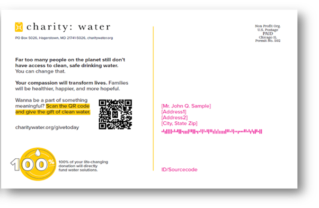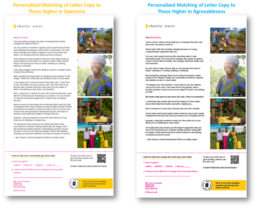charity: water Goes Mailing?
We did some very cool direct mail testing with charity: water. They’ve agreed to let us publish the results. Some things worked, others didn’t. We’ll share it all. This will be a two-part post but worth the ride and we’ll also combine both posts into a downloadable, single pdf for ease of future reference.
charity: water is a brand that screams innovation. They aren’t alone in that category but they fit squarely in it. For starters, they signup a ton of monthly donors from a long-form video posted on social and digital ad networks.
And they don’t use direct mail. Ah, the horror! No, it’s a rational choice. Equally rational is their interest in testing the value of direct mail, but not simply as a stand-alone, fulfillment route. They wanted a brand-building, tactile touchpoint adding to engagement and overall value.
And they didn’t want to treat everyone the same. They wanted personalized matching with behavioral science.
Let’s parse that mouthful out a bit.
Brand-building. If you think your direct mail isn’t building your brand and that isn’t its primary job then you should not be in the direct mail business. How so? The vast majority of people getting your direct mail don’t respond to it. Does that mean it had no value for the 95% +? It had an impact. It either made those people more or less likely to give in the future and since that’s the massive majority, the impact on that group matters more than the tiny responder group. It builds or destroys donor level equity, which is their future value. That is the sane definition of brand, building future value.
Not in vacuum: What if a mailing has hardly anyone sending back a paper check? Did it bomb? In most cases the analysis would say “yes”, bombed. But what if you had an extended view that looked at the possible influence of that mail touchpoint on other fulfillment channels, namely digital?
Not everyone is the same. It’s the norm for 99% of sector testing and fundraising to assume everyone is the same. charity: water is not the norm and needed an approach to personalized matching with rigor and evidence behind it.
Here is the experimental design.
It’s a 2×3 design. The Personalized Matching is based on Personality. How did we know who was Open and who was Agreeable?
We have a proprietary, validated set of 3rd party data for each of the Big Five Personality traits. We match each donor to the profiles and assign them based on best fit. Why Personality? It’s mostly innate, fixed and predictive of what we’ll find interesting and relevant. If your copy matches the person’s Personality, they’re more likely to see it, process it, agree with it and act on it.
The QR code test is self-explanatory, there was a QR code on the outer envelope.
The other version had the code on the reply form. Here is that letter and reply.
The post card test was premised on the idea that these are existing CW supporters who, at a bare minimum, are willing to transact online (and may prefer it) and have no need for additional messaging or narrative beyond what a landing page can provide.

The Personalized Matching by Personality had differing letter copy. Everything else was the same – main character, images in letter, signer, etc.

What’d We Find?
There was a holdout group who got the business-as-usual digital marketing but not the mail. And the test groups got what the holdout group got + mail.
First off, we got hardly any paper checks. Shockingly few. In a vacuum, the test bombed, big time. Fortunately, charity: water was as focused on the indirect lift as the direct. So, all results are over a 45 day time period looking at online + offline giving for the respective groups.
Format findings
- QR Code on Reply & OE is directionally better than on the reply alone. I say directional because rigid significance testing puts the result at 80% confidence and the p-value police will insist on the arbitrary 95% or 90% to flag as ‘significant’. This result is in line with what we’d expect, make it as easy and convenient as possible and don’t require someone to open the OE.
- Letter beats postcard. Did the postcard get lost in the shuffle of daily mailbox clutter? Did readers need or want more than what the postcard provided?
Sub-story: We did see the postcard do better with Agreeable folks than the Openness group. This is in keeping with what we’d expect. People high in Openness are not only capable of processing more (interesting) info but they like it. The postcard probably doesn’t ever match their preference and need. Agreeable folks want and require and respond to less.
Kevin
P.S. Part two on Wednesday will show the Personalized Match Findings (i.e. content matched to Personality) and the digital testing that was done.



hi Kevin, very interesting.
Can you share if Charity:water saw donations come in online from appeal and post card? no checks, understood because that’s not typically how their donors give.
Also, it’s unclear if these appeals/post cards were aimed at one-time donors or monthly donors?
Especially where so many nonprofits are looking to figure out what to do with their online donors.. can we send mail to them and if so, what should that look like, this would be a very interesting result.
The appeals were sent to past and previous one-time donors, no monthly. There was a monthly ask component to it. All donations were made online and tracked back to people who received the postcard, letter with QR on the OE or letter without the QR on the OE so all the results reported here were online. The response rate from people who received anything in the mail and responded online was 1.32% and 0.09% for monthly donors in particular. We calculated that it cost roughly $1200 to secure a monthly donor via mail here which is WAY too expensive overall but in relation to costs via other channels. Particularly as these were 1X donors who, in theory, should be more cost effective to acquire.
Fascinating, Kevin. Thanks for sharing. I can’t wait to see more on these tests you’re doing with Charity: water. I’m curious about the questions Erica poses as well. I’m one of those weird older donors who hasn’t written a check to a charity since the 90s; I always give online. But I’d say a large portion of my own giving is triggered by direct mail.
Love this. Thank you.
Wondering: what are some of the insights specific to charity:water (i.e., their company-specific takeaways for DM)? Their model is different to most, so I suppose more typical orgs would have to filter potential lessons accordingly, but I’d like to know, for example, how they might continue along these lines and what they might want to test next.
I think the charity:water model can point us toward the future, as digital habit migration will likely trend toward serving donors via an approach that’s more along these lines than not. I’d be interested in knowing whether or not you agree.
Great question Brett. Per my comment to Erica, we found the incremental cost to acquire a monthly donor was ~$1200 which is really high and outside of the window where we felt event with future optimizations and improvements it wouldn’t come down enough to warrant the time, energy, and cost so this type of approach in direct mail for the mass audience is essentially dead and won’t be revisited (at least not for a few years). DM will still be used for certain audiences and some postcards will be used in some campaigns but more focused and sparingly.
Interesting. Thanks so much, Brady. I appreciate your taking the time to reply!
DM Always intrigued. Thx!
How accurate do you think the matching to personality is?
Are similar databases available in the UK market?
Hi Andrew,
The matching is quite accurate and always useful to compare to the alternative of treating everyone the same. In a relative light all we need to be is better than the status quo and while that bar may be low, we leap over it with these tags. They are built from zero-party data where we collected Personality scores from real humans, over 10,000 in the dataset. This is what we combined with the almost 300 external data points that are full of noise and hard to find signal absent a plan. The plan here was computationally involved but conceptually simple – find correlations with traits and scores and from there, a combination of traits that do a good job as proxy for a trait while also discriminating from other traits.
We have further face validity given all that is known in the public/academic square about trait profiles and so there is qualitative comfort there – e.g. we’d expect extroverted people to match highly on outdoor activities and they do. We’d expec people high in Openness to match highly on international travel and they do.
Unfortunately, the answer to your second question is, “I’m not sure but I don’t think so”.